At my home in Michigan's
Lower Peninsula, early March means rain, robins, and rivulets
of water everywhere. As I assembled my equipment for this
trip--billed as "winter camping"--I wondered if
I would even need my snowshoes.
It was hard to keep adding heavy insulating
layers and extra fuel to my five-foot-long sledge, but by
the time I arrived at the trailhead, I was glad I had done
so.
Driving north, light snow-cover appeared
around West Branch. By the time John Herrgott, my carpooling
partner from Linden, and I reached the Mackinaw Bridge, there
was 5 to 6 inches of crusty snow on the ground.
Our destination was the Pictured Rocks
National Lakeshore backcountry and as we turned off M-28 near
Singleton, the snow depth increased markedly. Soon, there
was at least three feet lining the road.
As the sun set, we proceeded eastward to
a small parking area 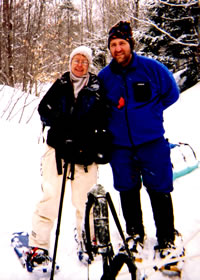 where
the snowplows turn around. Snow berms around the lot were
6 to 8 feet high. There we met our trip leader, Michael Neiger
of Marquette, and another hardy soul, Ed Pavwoski of Lansing. where
the snowplows turn around. Snow berms around the lot were
6 to 8 feet high. There we met our trip leader, Michael Neiger
of Marquette, and another hardy soul, Ed Pavwoski of Lansing.
Mary Powell of Flint
and Ed Pavwoski of Lansing
enjoy a break after sledging
through mixed hardwoods.
(Photo by Mary Powell)
After unloading our gear into sledges late
Thursday night, we donned snowshoes and pulled the sledges
up over the berm. Out of sight of the parking area, it was
as if civilization had disappeared. We were in a forest softly
lit by light reflected from the snow.
It was cold and absolutely quiet. The sounds
we made were muffled by the layer of white. We each chose
a spot, packed down the snow, set up our tarps, and settled
in for the night. I fell asleep watching snowflakes drift
lazily down at the edge of my tarp.
I awoke Friday morning to find my tarp
"roof" bulging inward from the weight of the snow
that had fallen through the night. The sky was overcast and
temperatures were somewhere in the upper 20's.
After a hearty breakfast and a hot drink,
we packed our gear to travel.
Conditions were ideal for sledging--several
inches of new snow on a hard crust over three or four feet
of snowpack. Still, I found walking on snowshoes pulling a
sledge loaded with sixty pounds of gear to be fairly strenuous.
As we left the parking area, we were greeted
by a group of passing snowmobilers. The expressions of those
who flipped up their facemasks clearly said they thought we
were nuts.
We headed off cross-country in a southeasterly
direction, Michael leading us with map and compass in-hand.
Ed, it turned out , is a GPS aficionado.
He provided high tech 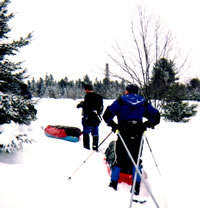 confirmation
off and on throughout the trip that we were, in fact, where
Michael said we were--not that there was ever much doubt! confirmation
off and on throughout the trip that we were, in fact, where
Michael said we were--not that there was ever much doubt!
John Herrgott of Linden
and Ed Pavwoski of Lansing
pause to check the map
while sledging through
the Kingston Plains.
(Photo by Mary Powell)
We traveled through varied countryside--mixed
evergreen/hardwood forest with some areas being a little more
open. The silence was intense for a person accustomed to the
constant noise of the city. The scenery was beautiful.
All the contours of the land were rounded
by the snow cover. Every stump looked like it was capped with
a marshmallow. Looking at the trees bending beneath the snow,
particularly the evergreens, you could almost feel the weight
they had been holding all winter.
Our travel was leisurely with frequent
breaks. Late in the afternoon, we sought out an area of hardwoods
to camp where there would be a good supply of firewood. Finding
a suitable spot, we set up an assortment of shelters.
Michael and I put up tarps--his being considerably
more secure than mine. Ed excavated a pit in the snow and
suspended his tarp over it, giving himself a good deal of
space and headroom.
In less than an hour, John and Michael
had dug a coffin-type snow shelter. While not spacious, such
a shelter definitely protects one from the elements--it's
windproof and the interior temperature remains well above
zero even in extreme cold.
A candle inside yields sufficient light
to read by. John looked like a kid crawling out of it and
he said it made him feel that way too. Once "dug in,"
he was one of the first to boil up and enjoy a hot drink after
a hard days sledge.
Accustomed to being indoors most of the
winter, it is uncomfortable, at first, to have the cold literally
in your face all the time--to realize there is no warm place
anywhere nearby to go to.
After a couple of nights of being out though,
you learn to trust your insulating layers and relax. Having
a fire can contribute to comfort too, as well as providing
heat to cook with and melt snow for water.
Once I had my tarp up, I got out my fire
pan, laid it on top of some 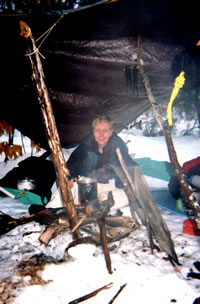 logs
to keep it from sinking into the snow, gathered some wood,
and built a small fire. John soon joined me. logs
to keep it from sinking into the snow, gathered some wood,
and built a small fire. John soon joined me.
Mary Powell of Flint
makes herself comfortable
under her tarp with a
small fire on a fire pan
that rests upon
4 feet of snow.
(Photo by Mary Powell)
I like the smell of wood smoke as well
as the activity of maintaining a fire and cooking over it.
It's some work, but it's also relaxing.
I sleep soundly in the woods. Sometime
during the night, I was aroused by the sound of Michael's
voice saying,"Hey, Mary! Get your snowshoes inside and
make sure all your gear is covered--it's raining and freezing
on everything."
After retrieving my snowshoes and checking
my stuff, I fell asleep again, listening to John snoring softly
in his shelter and the rain falling steadily on my tarp.
We awoke Saturday morning to a rare opportunity
for R&R--it was raining too hard to travel. Had we tried,
the sleds would have filled with water and we would have been
wet from the effort of sledging in waterproof gear.
We spent the morning enjoying the warmth
of the fire and conversation. Ed and Michael did some reading.
We ate breakfast and later lunch. The winds shifted back and
forth. The trees were sodden and lightly coated with ice.
The air filled intermittently with fog.
We watched and waited. In the early afternoon the rain slackened
to a drizzle and we decided to travel.
We dumped the water out of everything,
broke the ice off our gear, thawed the knots with our breath,
took down the shelters and packed. We headed east, planning
to pick up the Fox River Trail.
After a bit of scouting, the familiar blue
blazes appeared and we followed them along the ridges above
the river. The dark, open water of the river bordered by pines,
all softened by the drifting fog, created some awesome vistas.
The drizzle quickly changed to snow as
the wind shifted and the temperature dropped. Staying warm
without overheating became a fulltime job.
We left the trail where it intersected
an old railroad grade and began hunting for a suitable place
to camp. The wind was picking up and our wet outerwear was
beginning to stiffen with ice.
Michael's disclaimers for these trips always
include, "bivouacs will be deep in the bush...far from
dry and level campsites and fire rings." Our site for
the night definitely fit that description.
We put on some layers and set up our shelters.
Michael supplied us with a substantial pile of firewood and
we'd soon established a modicum of comfort.
A hot meal greatly improved my outlook.
Warm bottles of water melted from snow made my sleeping bag
toasty. Life was good again.
There was no question Sunday morning that
it was winter as temperatures had dropped to the single digit
range. We packed with some difficulty--ice stiffened gear
doesn't fold or compact very 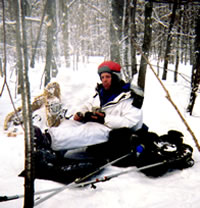 well--and
began to travel, circling back in the general direction of
our cars. well--and
began to travel, circling back in the general direction of
our cars.
Michael Neiger of
Marquette puts down a
1,000-calorie breakfast
in preparation for another day
of sledging south of
the Kingston Plains.
(Photo by Mary Powell)
The day of sledging went fairly smoothly
except that at one point I discovered my water bottle had
fallen from my belt and I had to backtrack a considerable
distance to retrieve it. The guys waited patiently for me
to return--or if they weren't patient, at least I didn't hear
about it!
There had been little evidence of wildlife
on this trip, probably due to the inclement weather. On this
morning though, we saw a couple of coyotes down the railroad
grade when a gust of wind-blown snow cleared. They paused
as if they were checking us out too, then disappeared into
the forest.
At one picturesque spot along our route,
a small creature had left tracks circling up to the top of
a conical mound of snow. It appeared the animal had gone up
there to survey the surrounding territory.
Sunday evening we camped in a fairly hospitable
area of mixed forest. Michael built a shelter he called a
blocked-in lean-to. It looked really comfortable--almost like
a small house.
I layered up and found you can, indeed,
remain comfortable at rest in the bush in the winter--without
a fire. Next time I will bring a book to read.
Before retiring, I went for a short walk
to build up some heat to warm my sleeping bag. Turning off
my headlamp away from camp, I was treated to the beauty of
the woodland scene that appeared out of total darkness--like
a fade-in in a movie--as my night vision returned.
As large snowflakes began to fall, I stood
awhile, taking in the gray trees silhouetted against pale
mauve/beige snow. Then, I slowly followed my snowshoe tracks
back to camp to retire for the evening.
Sunday morning, we awoke to winter wonderland.
During the night, falling snow had coated every tree and bush.
The early morning sun shining through light cloud cover made
everything seem golden at first, then dazzling white. It was
beautiful!
Chickadees were chattering nearby too.
Their cheerful voices made me feel that this was going to
be a good day. And it was. We didn't have far to go.
After a couple hours of sledging, mostly
through hardwoods alongside a snowmobile trail, we came upon
a plowed road, which eventually returned us to our cars.
Another good trip. When I see a winter-camping
opportunity listed in next year's trip listings, I'll be signing
up.
Read
another journal...
|


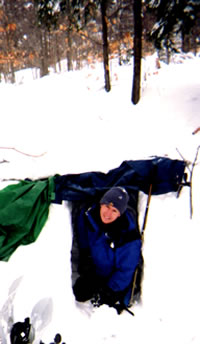
 where
the snowplows turn around. Snow berms around the lot were
6 to 8 feet high. There we met our trip leader, Michael Neiger
of Marquette, and another hardy soul, Ed Pavwoski of Lansing.
where
the snowplows turn around. Snow berms around the lot were
6 to 8 feet high. There we met our trip leader, Michael Neiger
of Marquette, and another hardy soul, Ed Pavwoski of Lansing.
 confirmation
off and on throughout the trip that we were, in fact, where
Michael said we were--not that there was ever much doubt!
confirmation
off and on throughout the trip that we were, in fact, where
Michael said we were--not that there was ever much doubt! logs
to keep it from sinking into the snow, gathered some wood,
and built a small fire. John soon joined me.
logs
to keep it from sinking into the snow, gathered some wood,
and built a small fire. John soon joined me.  well--and
began to travel, circling back in the general direction of
our cars.
well--and
began to travel, circling back in the general direction of
our cars.